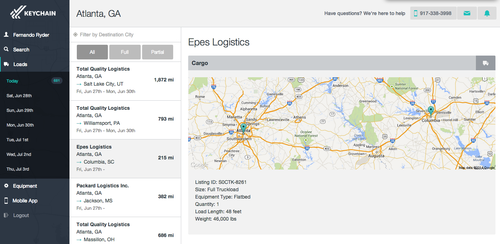
by Fronetics | Aug 14, 2014 | Blog, Marketing, Social Media, Strategy, Supply Chain
We want to hear from you! 
We want to know what questions you have about:
- Demand generation
- Establishing and growing an online presence
- Social media
- Content
These categories are intentionally broad because we want to you to think about any (and all) questions and pain points you might have related to these topics.
Remember the adage – there is no stupid question.
Why do we want to hear from you?
We have an upcoming series of blog posts that are focused on answering questions that companies within the supply chain industry have regarding demand generation, an online presence, social media, and content. We want to give you the opportunity to ask your questions and state your challenges so that your questions and challenges can be addressed.
How can you be heard?
Fill out the form below or content with us via Twitter or LinkedIn.

by Fronetics | Aug 14, 2014 | Blog, Marketing, Social Media, Strategy, Supply Chain
We want to hear from you! 
We want to know what questions you have about:
- Demand generation
- Establishing and growing an online presence
- Social media
- Content
These categories are intentionally broad because we want to you to think about any (and all) questions and pain points you might have related to these topics.
Remember the adage – there is no stupid question.
Why do we want to hear from you?
We have an upcoming series of blog posts that are focused on answering questions that companies within the supply chain industry have regarding demand generation, an online presence, social media, and content. We want to give you the opportunity to ask your questions and state your challenges so that your questions and challenges can be addressed.
How can you be heard?
Fill out the form below or content with us via Twitter or LinkedIn.

by Fronetics | Aug 12, 2014 | Blog, Content Marketing, Marketing, Social Media, Supply Chain

Connectivity, mobility and accessibility are game changers for business. Companies that recognize this and adapt accordingly will succeed, companies that don’t will not.
Unnovation
Olaf Swantee, CEO of EE, calls this refusal to innovate “unnovation” and defines it as the following:
If unnovation ever made it into the Oxford English Dictionary, I believe the description would be something along the lines of “unnovation (noun) … the refusal to identify, create, embrace or adopt new ideas, leading to the unnecessary and un-timely end to a business, which is ultimately overtaken by external progress.
What are companies who have fallen prey to unnovation? Yell (Google), Borders (Amazon), and Blockbuster Video (Netflix) are just three examples.
Companies within the supply chain, and the supply chain industry in general, are at risk of falling prey to unnovation despite being in a prime position to innovate.
Unnovation and the supply chain
KPMG’s 2013 Global Manufacturing Outlook reported that the US manufacturing sector “seems primed for an era of ‘hyper-innovation,’ in which companies develop not only new products, but also entirely new ways to build them.” Unfortunately, companies within the manufacturing sector are not primed for innovation. KPMG found that 44 percent of survey respondents reported that they still use “old” technologies such as email, fax, and “snail” mail to manage their supply chains.
Similarly, the supply chain industry has been slow to participate in social media and to invest in creating a strong online presence. The primary reason: a lack of understanding of the business case or value.
Participating in social media and investing in creating a strong online presence are fundamentally different from the traditional strategies which companies within the supply chain industry have employed to attract new customers, foster relationships with current customers, communicate with partners, and grow their bottom line. Because of the stark contrast between “old” and “new,” companies do not recognize how these strategies can positively impact their bottom line and therefore decide to steer clear – they feel engaging is too risky. The reality is that not participating is risky; not participating is unnovation.
These companies embrace change
Keychain Logistics
Companies that choose to unnovate will be eclipsed by companies who embrace the world of mobility, connectivity and accessibility. Keychain Logistics is one company that has decided to embrace change.
Bryan Beshore, Keychain’s founder, recognized the changes taking place and decided not just to embrace them, but to also capitalize on them. Keychain leveraged the ideas of mobility, connectivity and accessibility and created a new way for the freight transportation industry to conduct business. Keychain is a marketplace that connects drivers directly with shippers – and is available via mobile app.
Keychain has also become an active participant on social media. This participation has enabled the company to shape their offering with a solid understanding of what people want from a transportation provider. Furthermore, Beshore notes that social media has helped grow their business: “From phone calls to interviews, crowdfunded campaign partnerships, and beyond, social media has certainly helped us grow our business.”
Cerasis
Another company that has been successful – Cerasis. For 15 years the freight logistics company used traditional sales and marketing strategies. This strategy worked; however, the company recognized that if it were going to remain competitive and grow it needed to adapt. The company launched a digital, social media, and content marketing strategy. The strategy lead to an increase in website traffic of close to 670 percent, an increase in search visits by close to 2,190 percent and, most importantly, the company acquired 35 new customers – a significant number for the industry.
Swantee believes that if companies choose unnovation, “Ultimately, it could lead to disastrous consequences for their businesses, their staff and their future.” I agree. If a company wants to remain relevant and competitive, and if a company wants to grow – it needs to recognize that connectivity, mobility and accessibility are game changers for business.

by Fronetics | Aug 12, 2014 | Blog, Content Marketing, Marketing, Social Media, Supply Chain

Connectivity, mobility and accessibility are game changers for business. Companies that recognize this and adapt accordingly will succeed, companies that don’t will not.
Unnovation
Olaf Swantee, CEO of EE, calls this refusal to innovate “unnovation” and defines it as the following:
If unnovation ever made it into the Oxford English Dictionary, I believe the description would be something along the lines of “unnovation (noun) … the refusal to identify, create, embrace or adopt new ideas, leading to the unnecessary and un-timely end to a business, which is ultimately overtaken by external progress.
What are companies who have fallen prey to unnovation? Yell (Google), Borders (Amazon), and Blockbuster Video (Netflix) are just three examples.
Companies within the supply chain, and the supply chain industry in general, are at risk of falling prey to unnovation despite being in a prime position to innovate.
Unnovation and the supply chain
KPMG’s 2013 Global Manufacturing Outlook reported that the US manufacturing sector “seems primed for an era of ‘hyper-innovation,’ in which companies develop not only new products, but also entirely new ways to build them.” Unfortunately, companies within the manufacturing sector are not primed for innovation. KPMG found that 44 percent of survey respondents reported that they still use “old” technologies such as email, fax, and “snail” mail to manage their supply chains.
Similarly, the supply chain industry has been slow to participate in social media and to invest in creating a strong online presence. The primary reason: a lack of understanding of the business case or value.
Participating in social media and investing in creating a strong online presence are fundamentally different from the traditional strategies which companies within the supply chain industry have employed to attract new customers, foster relationships with current customers, communicate with partners, and grow their bottom line. Because of the stark contrast between “old” and “new,” companies do not recognize how these strategies can positively impact their bottom line and therefore decide to steer clear – they feel engaging is too risky. The reality is that not participating is risky; not participating is unnovation.
These companies embrace change
Keychain Logistics
Companies that choose to unnovate will be eclipsed by companies who embrace the world of mobility, connectivity and accessibility. Keychain Logistics is one company that has decided to embrace change.
Bryan Beshore, Keychain’s founder, recognized the changes taking place and decided not just to embrace them, but to also capitalize on them. Keychain leveraged the ideas of mobility, connectivity and accessibility and created a new way for the freight transportation industry to conduct business. Keychain is a marketplace that connects drivers directly with shippers – and is available via mobile app.
Keychain has also become an active participant on social media. This participation has enabled the company to shape their offering with a solid understanding of what people want from a transportation provider. Furthermore, Beshore notes that social media has helped grow their business: “From phone calls to interviews, crowdfunded campaign partnerships, and beyond, social media has certainly helped us grow our business.”
Cerasis
Another company that has been successful – Cerasis. For 15 years the freight logistics company used traditional sales and marketing strategies. This strategy worked; however, the company recognized that if it were going to remain competitive and grow it needed to adapt. The company launched a digital, social media, and content marketing strategy. The strategy lead to an increase in website traffic of close to 670 percent, an increase in search visits by close to 2,190 percent and, most importantly, the company acquired 35 new customers – a significant number for the industry.
Swantee believes that if companies choose unnovation, “Ultimately, it could lead to disastrous consequences for their businesses, their staff and their future.” I agree. If a company wants to remain relevant and competitive, and if a company wants to grow – it needs to recognize that connectivity, mobility and accessibility are game changers for business.

by Jennifer Hart Yim | Aug 7, 2014 | Blog, Marketing, Social Media, Supply Chain, Transportation & Trucking
This guest post is written by Keychain Logistics. Keychain Logistics is a leading transportation provider enabling businesses to directly engage carriers, track shipments, and monitor its logistics needs online.

It’s 2012. Platforms like Uber, Airbnb, and Homejoy are growing rapidly. New customers are signing up via search, paid referrals, and social media. Marketing teams at each are delicately balancing the supply and demand of their output with a spread of calculations that, if not projected carefully, may lead to service outages and upset customers.
Now what’s going on here, and what does this have to do with logistics?
The companies above, alongside many others eating the world today with software, are all marketplaces.
Speaking in online terms, a marketplace is where buyers and sellers of a particular product or service can collaborate in a streamlined process to achieve what they want from the other side.
In exchange for facilitating relationships, thus saving time and resources for the entities wanting to connect, marketplaces may charge subscription fees, transaction commissions, or depend simply on high traffic volume to sell other assets like media space or proprietary content.
But facilitating relationships is only a necessary component, and not a sufficient one, to the success of a marketplace. This is because some buyers and sellers feel that the benefit of a marketplace has been fully realized upon their connection, and thus don’t stick around for the platform to send a bill.
What marketplaces must do to maintain engaged users, then, is create experiences inside the application that remove the incentive to circumvent it. And this is a tough challenge to solve.
One great example of this is Odesk.com, a marketplace connecting freelancers with employers who have projects to outsource. In exchange for this service, Odesk charges a 10% fee to employers per transaction. While this may sound steep, Odesk meets this ask with a suite of free management tools such as random monitor screenshots that let employers track the productivity of an outsourced team member without worrying about being overbilled on hours.
For freelancers, Odesk requires employers to place valid credit cards on file pre-hire, protecting them from employers who might otherwise attempt to avoid a payment. Tools like this make the Odesk platform (and its fees) worth every penny, thus creating a winning marketplace that helps both sides get what they deserve.
That said, let’s get back to logistics and how Keychain Logistics fits into this marketplace, value-adding, supply and demand spectrum.
The transportation industry is one of the largest, oldest conglomerates on the planet, with millions of drivers and thousands of shippers and brokerages in the US alone. The industry is also a fragmented one, with the biggest brokerage only commanding ~3% market share.
If anything is clear about business, it is that markets become more efficient through consolidation. From Coca-Cola buying a new beverage brand to a toy manufacturer owning its own factories, market consolidation is a common practice and, if done right, typically results in positive benefits for end-customers such as lower prices, higher quality, and so forth.
But for a myriad of reasons we won’t go into today, this kind of consolidation has yet to happen in the transportation industry.
Introducing Keychain.
Keychain is a marketplace connecting drivers directly with shippers, and the benefits are three-fold:
1. Shippers (effectively, employers) can bypass expensive commissions by man-powered brokerages,
2. drivers can book loads while on the go, and
3. Keychain verifies user insurance policies and other legal compliance measures, prior to allowing entry to the platform.
To achieve the win-win harmony of a successful marketplace, not only does Keychain facilitate the relationships but it also addresses the circumvention component with tools for drivers and shippers such as mobile apps, online dashboards, easy payment gateways, and in-app communications between parties.
Keychain is the technological consolidation of a market that just won’t give up its antiquated methods. Together, we can bring much needed efficiency to the efficiency business: logistics.





